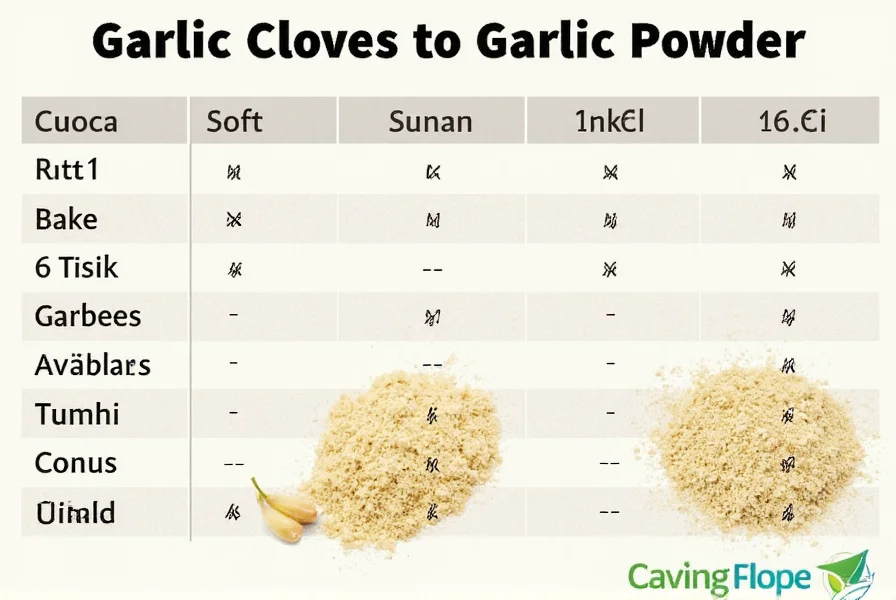Understanding garlic conversions is essential for consistent cooking results. When substituting garlic powder for fresh cloves, you're working with a concentrated form that lacks the moisture of fresh garlic but delivers more intense flavor per volume.
The Science Behind Garlic Conversions
Garlic undergoes significant transformation when converted from fresh cloves to powder. Fresh garlic contains about 60-65% water, while garlic powder is nearly 100% concentrated garlic solids. This fundamental difference explains why the conversion isn't a simple 1:1 ratio.
When garlic is dehydrated and ground into powder, the water evaporates, leaving behind the potent flavor compounds in a much more concentrated form. This concentration effect means you need significantly less powder to achieve similar flavor intensity to fresh garlic.
Garlic Measurement Conversion Chart
| Garlic Cloves (Fresh) | Garlic Powder Equivalent | Garlic Salt Equivalent* |
|---|---|---|
| 1 medium clove | 1/8 teaspoon | 1/4 teaspoon |
| 2 medium cloves | 1/4 teaspoon | 1/2 teaspoon |
| 3 medium cloves | 3/8 teaspoon | 3/4 teaspoon |
| 4 medium cloves | 1/2 teaspoon | 1 teaspoon |
| 6 medium cloves | 3/4 teaspoon | 1 1/2 teaspoons |
| 8 medium cloves | 1 teaspoon | 2 teaspoons |
*Note: Garlic salt contains additional sodium. When substituting garlic salt, reduce added salt in your recipe accordingly.
When to Adjust the Standard Conversion
While the 1:1/8 ratio serves as an excellent starting point for garlic cloves to garlic powder conversion, certain factors may require adjustments:
- Recipe type: Delicate dishes like fish or light sauces may need slightly less powder to prevent overpowering flavors
- Garlic variety: Larger elephant garlic cloves may require up to 1/4 teaspoon powder per clove
- Recipe age: Older recipes often call for more garlic than modern palates prefer
- Personal preference: Some cooks prefer slightly more or less garlic intensity
For best results, add garlic powder gradually and taste as you cook. Unlike fresh garlic, you cannot remove excess powder once incorporated into your dish.
Flavor Profile Differences
Understanding the flavor differences between fresh garlic and garlic powder is crucial for successful substitution. Fresh garlic offers:
- A brighter, more complex flavor profile
- Enzymatic reactions that develop when crushed (alliinase creating allicin)
- Subtle sweetness when cooked slowly
- Moisture that affects recipe texture
Garlic powder provides:
- More consistent, concentrated flavor
- No enzymatic development (already processed)
- Slightly different flavor compounds due to dehydration
- No additional moisture to recipes
For dishes where garlic is a primary flavor component, consider using a combination of both forms for layered flavor complexity.

Making Your Own Garlic Powder
For superior flavor compared to store-bought options, consider making your own garlic powder. The process preserves more of garlic's natural compounds:
- Peel fresh garlic cloves completely
- Slice thinly (1/8 inch) for even drying
- Air dry for 10-14 days or use a food dehydrator at 135°F (57°C) for 8-12 hours
- Grind dried slices in a spice grinder until fine powder forms
- Store in an airtight container away from light
Homemade garlic powder typically has a more vibrant flavor than commercial versions, which often undergo high-heat processing that diminishes flavor compounds. When using homemade powder, you may find you need slightly less than the standard conversion ratio due to its superior potency.
Storage Considerations for Both Forms
Proper storage affects both the shelf life and potency of garlic in either form:
- Fresh garlic: Store in a cool, dark, well-ventilated place (not the refrigerator). Properly stored, fresh garlic maintains peak quality for 3-6 months.
- Garlic powder: Store in an airtight container away from heat and light. Quality begins declining after 6 months, with significant flavor loss by 12-18 months.
Older garlic powder loses potency, which means you may need to use slightly more than the standard conversion ratio. Always check the freshness of your garlic powder by scent before using it in precise recipes.
Common Substitution Mistakes to Avoid
When converting between fresh garlic and garlic powder, watch for these common errors:
- Using equal volumes (1 clove = 1 teaspoon powder) - this creates overpowering results
- Not accounting for garlic powder's lack of moisture in recipes
- Adding garlic powder too early in cooking, causing bitter flavors
- Using old, stale garlic powder that has lost potency
- Confusing garlic powder with garlic salt (which contains 3:1 salt to garlic ratio)
For best results with garlic powder, add it during the last 10-15 minutes of cooking to preserve flavor compounds that can become bitter with prolonged heat exposure.
Practical Application in Recipes
Understanding garlic conversions becomes particularly important when adapting recipes:
- Pasta sauces: For marinara calling for 4 cloves, use 1/2 teaspoon powder added near the end of cooking
- Roasted vegetables: For 6 cloves in roasting, use 3/4 teaspoon powder tossed with vegetables before roasting
- Marinades: For 3 cloves in marinade, use 3/8 teaspoon powder combined with other dry spices
- Baking: In bread recipes calling for fresh garlic, use half the standard conversion (garlic intensifies during baking)
When converting older family recipes that call for "a head of garlic," remember that a standard head contains approximately 10-12 cloves, which would equal 1 1/4 to 1 1/2 teaspoons of garlic powder.











 浙公网安备
33010002000092号
浙公网安备
33010002000092号 浙B2-20120091-4
浙B2-20120091-4